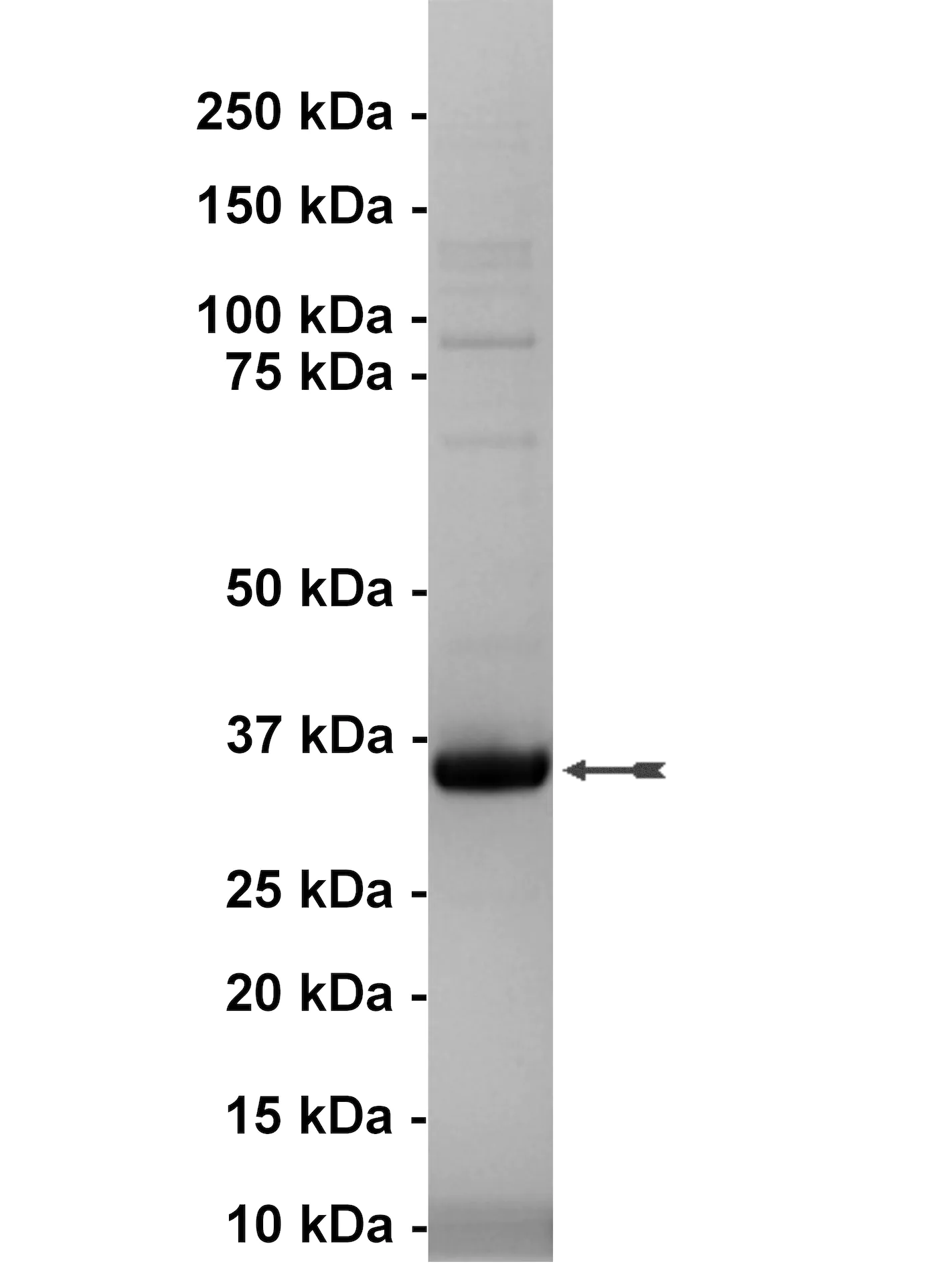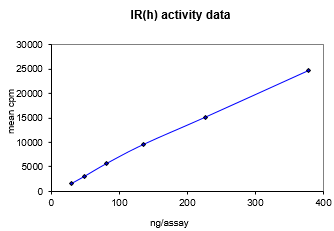Insulin Receptor, active Human Recombinant Kinase Protein
N-terminal 6His-tagged recombinant, human Insulin receptor amino acids 1005-1310.
Biological information
Background
The insulin receptor kinase (IRK) is composed of two extracellular a-subunits (135 kDa), which contain the insulin-binding site, and two intracellular b-subunits (95 kDa), containing the protein tyrosine kinase domain. After insulin binding, the insulin-IRK complex internalizes into muscle and fat cells. The IRK substrates of IRS-1 and IRS-2 form complexes, through Src homology region 2 (SH2) domains, with docking molecules such as phosphoinositde-3-kinase (PI3K). The recruitment of PI3K in turn activates phosphoinositide-dependent kinases, which serve in the activation of protein kinase B (Akt) and atypical isoforms of protein kinase C (PKC). These activated kinases then phosphorylate downstream effectors, ultimately promoting the translocation of insulin-sensitive glucose transporter subtype 4 (GLUT-4) to the plasma membrane, to operate in the coordination of glucose metabolism.
GenBank NM_000208
Target class
Kinase
Family
TK
Accession number
NM_000208.2; NM_001079817.1
Target Name
Insulin Receptor, active Human Recombinant Kinase Protein
Target Alias
INSR, CD220, IR, HHF5
Origin
Human
Theori. MW
36.8 kDa
Affinity tag
6His
Product specifications
Expression system
Expressed by baculovirus in Sf21 insect cells
Purity
Refer to CoA for Purity
Purification method
Ni2+/NTA-agarose
Sample Buffer
Specified activity
Refer to CoA
Application
For Research Only
Storage conditions
1 year at -70°C
Usage disclaimer
For Research Only
Chemical data
Background
The insulin receptor kinase (IRK) is composed of two extracellular a-subunits (135 kDa), which contain the insulin-binding site, and two intracellular b-subunits (95 kDa), containing the protein tyrosine kinase domain. After insulin binding, the insulin-IRK complex internalizes into muscle and fat cells. The IRK substrates of IRS-1 and IRS-2 form complexes, through Src homology region 2 (SH2) domains, with docking molecules such as phosphoinositde-3-kinase (PI3K). The recruitment of PI3K in turn activates phosphoinositide-dependent kinases, which serve in the activation of protein kinase B (Akt) and atypical isoforms of protein kinase C (PKC). These activated kinases then phosphorylate downstream effectors, ultimately promoting the translocation of insulin-sensitive glucose transporter subtype 4 (GLUT-4) to the plasma membrane, to operate in the coordination of glucose metabolism.
GenBank NM_000208
Compound name
Kinase
Catalog number
14-466
Molecular formula
CAS
MW
Ka
Percent composition
Product specifications
Physical state
Purity (HPLC 214nm)
Retention time (RP18 HPLC)
CMC
Exact mass
Stability
For Research Only
Solubility structure
Kinase Activity Assay Biological information
Background
The insulin receptor kinase (IRK) is composed of two extracellular a-subunits (135 kDa), which contain the insulin-binding site, and two intracellular b-subunits (95 kDa), containing the protein tyrosine kinase domain. After insulin binding, the insulin-IRK complex internalizes into muscle and fat cells. The IRK substrates of IRS-1 and IRS-2 form complexes, through Src homology region 2 (SH2) domains, with docking molecules such as phosphoinositde-3-kinase (PI3K). The recruitment of PI3K in turn activates phosphoinositide-dependent kinases, which serve in the activation of protein kinase B (Akt) and atypical isoforms of protein kinase C (PKC). These activated kinases then phosphorylate downstream effectors, ultimately promoting the translocation of insulin-sensitive glucose transporter subtype 4 (GLUT-4) to the plasma membrane, to operate in the coordination of glucose metabolism.
GenBank NM_000208
Target class
Kinase
Family
TK
Subfamily
Protein Name
IR
Protein Alias
INSR, CD220, IR, HHF5
Accession Number
NM_000208.2; NM_001079817.1
UniProt Number
Gene Name
Gene ID
Gene Aliases
Target Species
Human
Kinase Activity Assay Usage
Product Type
Application
Storage Conditions
1 year at -70°C
Usage disclaimer
Kinase Activity Assay Information
Assay Type
Assay Measures
Biological Information
Background
The insulin receptor kinase (IRK) is composed of two extracellular a-subunits (135 kDa), which contain the insulin-binding site, and two intracellular b-subunits (95 kDa), containing the protein tyrosine kinase domain. After insulin binding, the insulin-IRK complex internalizes into muscle and fat cells. The IRK substrates of IRS-1 and IRS-2 form complexes, through Src homology region 2 (SH2) domains, with docking molecules such as phosphoinositde-3-kinase (PI3K). The recruitment of PI3K in turn activates phosphoinositide-dependent kinases, which serve in the activation of protein kinase B (Akt) and atypical isoforms of protein kinase C (PKC). These activated kinases then phosphorylate downstream effectors, ultimately promoting the translocation of insulin-sensitive glucose transporter subtype 4 (GLUT-4) to the plasma membrane, to operate in the coordination of glucose metabolism.
GenBank NM_000208
Target class
Kinase
Family
TK
Accession Number
NM_000208.2; NM_001079817.1
Target Name
IR
Target Alias
INSR, CD220, IR, HHF5
Origin
Human
Theoretical MW
Affinity Tag
6His
Product Specifications
Expression system
Expressed by baculovirus in Sf21 insect cells
Purity
Refer to CoA for Purity
Purification method
Ni2+/NTA-agarose
Sample Buffer
Specified activity
Refer to CoA
Application
Storage conditions
1 year at -70°C
Usage disclaimer
For Research Only
Biological Information
Background
The insulin receptor kinase (IRK) is composed of two extracellular a-subunits (135 kDa), which contain the insulin-binding site, and two intracellular b-subunits (95 kDa), containing the protein tyrosine kinase domain. After insulin binding, the insulin-IRK complex internalizes into muscle and fat cells. The IRK substrates of IRS-1 and IRS-2 form complexes, through Src homology region 2 (SH2) domains, with docking molecules such as phosphoinositde-3-kinase (PI3K). The recruitment of PI3K in turn activates phosphoinositide-dependent kinases, which serve in the activation of protein kinase B (Akt) and atypical isoforms of protein kinase C (PKC). These activated kinases then phosphorylate downstream effectors, ultimately promoting the translocation of insulin-sensitive glucose transporter subtype 4 (GLUT-4) to the plasma membrane, to operate in the coordination of glucose metabolism.
GenBank NM_000208
Target class
Kinase
Family
TK
Accession Number
NM_000208.2; NM_001079817.1
Target Name
IR
Target Alias
INSR, CD220, IR, HHF5
Origin
Human
Theoretical MW
Affinity Tag
6His
Product Specifications
Expression system
Expressed by baculovirus in Sf21 insect cells
Purity
Refer to CoA for Purity
Purification method
Ni2+/NTA-agarose
Sample Buffer
Specified activity
Refer to CoA
Application
Storage conditions
1 year at -70°C
Usage disclaimer
For Research Only





